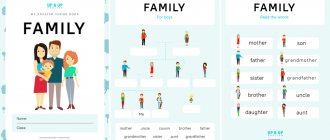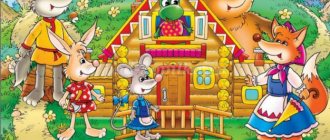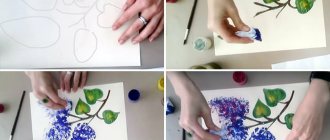Notes of OOD in English (20 notes) lesson plan (senior group)
Lesson outline on the topic: “Colors”. (senior group) (Stereotyping-situational stage - formation of automation).
Goal: development of lexical and grammatical skills using a fairy tale on the theme “Colors”.
Tasks:
1. Teach children new lexical units on the topic “Colors”: purple, golden, beige, turquoise.
2. Continue to teach children to act according to the model.
3. Continue teaching children to use speech patterns: “It is…”, “I like…” “What is it?”.
Language material for active use in speech:
-names of colors (green, yellow, red, blue, pink, brown, orange, grey, white, black, purple, golden, beige, turquoise).
Language material for recognition:
-commands (Let's see it, Let's repeat, Please, take your chairs and go out!)
Expected results:
1. Children will be able to act according to the model.
2. Children will learn to use speech patterns “It is…”, “I like…” “What is it?” using LE on the topic: “Colors”.
3. The children mastered the proposed language material.
1. Organizational moment. (3 min)
T: “Hello, my dear children! I am glad to see you! How are you?”
CH: “I am fine”
T: “Very well! I am fine too!”
T: “Guys, let’s start our lesson by repeating our greeting poem! Turn to each other and say good morning!” (Poem)
SN: Good morning, good morning,
Good morning to you,
Good morning, good morning,
I'm glad to see you.
T: “Good for you! Well done!”
2. Main part. (21 min)
T: “Children, they are many colors in English. Let's see it! (On the board there are cards of the colors that the children already know (Green, red, blue, yellow, brown, white, black, orange, grey, pink)). Please name these colors. For example, it is green. What is it?” (Children take turns calling the colors, then ask each other). (2 min)
T: “That`s right! And now I will tell you a fairy tale about the octopus Gosha. I'm sure you'll like it! Only some of the words in it are written in English, so when you hear them, say them out loud in Russian! All right? Agreed?
SN: “Yes”
T: “In the huge deep ocean lives the octopus Gosha. He likes everything colorful, beautiful, bright. That's why he loves to look at small fish that move in moving schools here and there... They are very bright, colorful and cheerful!
And for many days the octopus dreams that someday he will learn to draw, and that he will always be surrounded by colorful paintings. And so, Gosha began to look for paints, because there is so much on the bottom of the ocean! But he always came across something wrong - shipwrecks, chests, even skeletons...
Finally, he found jars of paints among other things, lined them up in front of him and began to examine them. “Oh, what wonderful, magnificent colors!” - Gosha said.
“Here is green, it’s like algae; This is yellow, it’s like sand.”
Seeing a jar of red paint, Gosha thought about it. What does red look like? Oh yes! “red is like coral, and blue is like the sky!” Even an octopus living in the depths of the ocean knows what color the sky is, because it also sometimes looks up...
At that moment, a school of fish swam by. They were so beautiful and colorful! And pink, and brown, and orange, and grey! And everyone was scurrying up and down!
And Gosha, too, admiring them, looked up and down! And so, when he looked up again, the octopus saw the white sail of a yacht through the water. It was beautiful too. He liked white as well as other colors.
Gosha, returning to his jars and remembering what colors he had seen during the day, began to test his memory. Looking at his “treasures,” he said: “green looks like grass and algae; - yellow looks like sand and the sun; -red, same as corals; - blue, the same as the sky! And these colors - pink, brown, orange, gray - are like the scales of cheerful little fish that swam up and down.
And Gosha had two more colors in jars. One of them is white, like the sail of the yacht he saw that day. And the other color is black. Gaucher didn't really like this color.
He reminded him of the not best days of his childhood, when his mother scolded little Gosha because his neck was dirty and black. “And how did I manage to get my neck dirty, being in the water all the time?” - the matured Gosha sometimes thought.
Now he understood his mother. I also understood that a dirty and black neck is ugly. But, the octopus thought, if you paint everything black, and then draw patterns or fish on top in different, bright colors, it will be beautiful...
Gosha is very tired. He went to bed and fell asleep happy. Because tomorrow he will DRAW!” (8 min)
T: “Guys, did you like the fairy tale?”
SN: “Yes!”
T: “That's great! Wonderful! But you and I don’t know the names of all flowers, would you like to know a few more? Then look at our magical flower! Look at the magic flower! What colors are its petals?
CH: “purple, golden, beige, turquoise.”
T: “That`s right! Purple will be purple in English. Repeat, please! For example, a purple ball. Golden will be golden. Repeat, please all together! For example, a golden ball. Beige will be beige, a beige ball. And turquoise is turquoise, a turquoise ball. Let's repeat!" (together and individually). (5 min)
T: “Good for you, my dears!” Well, have you stayed too long? Stand up, my children!” (Physical education minute)
When I see red I put my hands on my head.When I see blue I touch my shoe. When I see green I wash my face real clean. When I see yellow I wave to the fellows. When orange is found I put my hands on the ground. When I see pink I think, I think, I think. (2 times)
T: “Very well! Sit down, please!” (2 min)
T: “Now let’s mix our paints (pictures with colors are mixed and turned face down) and play “Yes or no,” okay?” (Children take turns taking out one card with a color, look at the color, but do not show it to anyone, and others must guess this color using the questions “Is it...?”. The one who guesses takes the place of the leader).
T: “Kira, is it red?”
SN: “No, it isn`t” (Further according to the sample).
T: “That's perfectly correct. Absolutely right." (4 min)
3. Final part. (2 min)
T: “Guys, what new colors did we learn today? What did you like most about today's lesson?
SN: “I found out that purple is purple in English”
T: “Well done! Our lesson is over! Thanks for good job! Please, take your chairs and go out!”
English for preschoolers
Contained in sections:
Includes sections:
Consulting parents when organizing online English classes In a pandemic, distance learning is necessary as part of lifelong education. Based on this, a program was created to continue learning English on the basis of a bilingual group. for the implementation of distance learning in English .
Using the immersion method in English classes at preschool educational institutions The requirements of our society for the level of mastery of a foreign language are growing every day. Modern language classes are not just about repeating new words and phrases after the teacher and clarifying the meaning using the native language , it is an integrated approach aimed at developing language skills .
Publication “Use of new technologies in English classes in. “Our life does not stand still and modern classes and lessons in a foreign language are not just repeating new words and phrases after the teacher and clarifying the meaning using their native language, it is an integrated approach aimed at developing language competence in children. With help.
Health-saving technologies used in English classes at preschool educational institutions Preserving the health of preschool children is a priority area of education. The key positions of modern English classes from the point of view of health protection include not only taking into account the individual characteristics of preschool children, a differentiated approach to children with.
Consultation “English for Children” Parents strive to introduce their children to learning English already in infancy. What could this be - a tribute to fashion or a desire to use the opportunity to experiment and get real results? Controversy over learning English in kindergarten.
Summary of an open lesson on teaching Russian-speaking children Tatar and English “Multi-colored dishes” Summary of an open lesson on teaching Russian-speaking children Tatar and English “Multi-colored dishes”. Developed and conducted by teacher Leontyeva E.A. Topic: “Multi-colored dishes” Program objectives: Expand children’s vocabulary in the Tatar language, develop the ability to understand.
Article “Tips for parents on teaching children English at home (in the summer.” Summer holidays come, when you don’t have to rush to kindergarten in the morning, when there is a lot of free time that can (and should) be spent usefully. In a relaxed atmosphere it is very useful turn on simple cartoons and audio recordings for your baby while he plays, makes noise, and runs around.
Outline of an English language lesson in a preparatory group Outline of joint educational activities with children 6-7 years old in English Educator of the MADOU "KINDERGARTEN No. 11" in Zarechny, Penza region Inna Konstantinovna Makovskaya Goal: to develop children's interest in learning English language through songs and rhymes.
Source
How to individualize work with children in the process of educational activities in English
Issues of individualization of work with children are relevant for learning English, since its development depends on the characteristics of the memorization process, the ability to concentrate on a particular type of activity, as well as on the type of temperament: choleric people, as a rule, comprehend new material more easily than phlegmatic people. An individual approach to developing correct pronunciation, which is determined by the child’s speech development, deserves special attention. Some people can easily repeat the sound complexes of a foreign word, while others cannot reproduce even half of the sounds in the correct order. Work with such children should be based on the technique of choral repetition: first, the teacher pronounces the word himself, and then together with the child. In this case, with each repetition, the volume of the adult’s voice should decrease and gradually fade away. In addition, the methods of individualization are:
The task of individualization is to find a task to suit each child’s taste, that is, to create conditions for a situation of success.
Work program for English in kindergarten
The order of presentation of the material and essence of the English language course is determined by the work program, which is drawn up by a foreign language teacher with the assistance of a senior educator and methodologist based on the general educational program of the preschool educational institution. That is, work programs in kindergartens may be different, but the requirements for drawing up a program document and the results of work for the first year will be the same.
Principles for drawing up a work program in a foreign language
The requirements for drawing up a work program are determined by the Federal State Educational Standard (FSES):
Learning new material in English is built on the basis of what has already been mastered
Results of the first year of teaching English at a preschool educational institution
By the end of the first year of learning English, the child should know:
This is interesting. In parallel with the study of lexical material, children become familiar with the alphabet.
Examples of drawing up work programs
As already noted, depending on the settings of the general educational program and the availability of a specialist, the English language program can be designed for 2 or 3 years:
The work program also determines the necessary material and technical equipment for classes, for example, teaching aids
General recommendations, literature
The variety of English lessons for kids is endless. Drawing and coloring, modeling, crafts, songs and dances, skits, active and role-playing games - all this can and should be organically included in classes. It is useful and fun for children to study in a group, but if you wish, it is easy to organize training for your child yourself at home. In this case, it is worth choosing a good textbook to rely on.
Experts recommend using textbooks by English-language authors, written entirely in English. Among them are guides for beginners - for example, the Activity Book for Children from Oxford, which contains several parts of a fascinating coloring book on which objects are labeled in a certain color. During the coloring process, the child will remember the names of the colors.
Picture Grammar for Children is another picture-based textbook. It is intended for children who have already passed the elementary level. Here, students are encouraged not only to memorize new words, but also to learn to write them, compose sentences from them, and answer questions. In an easy and unobtrusive form, the child will train oral speech skills, and this is exactly what is primarily meant by language proficiency. There are also excellent Russian-language textbooks and tutorials, for example, “English for Kids” edited by N. A. Bonk (authors I. A. Shishkova, M. E. Verbovskaya) . Equipped with interesting audio materials, it is perfect for working with children 4-6 years old.
The book “English for Children. Great tutorial" by Sergei Matveev . The information in it is presented clearly and in detail so that parents can easily work with their children on their own.
When deciding whether it is necessary to teach English to a child under 6-7 years old, it is worth considering that such classes will not only benefit him in preparation for school, but will also broaden his horizons and help him feel more confident in the company of his peers. You shouldn’t expect your child to speak English right away, but there is no doubt that the acquired knowledge will come in handy when learning the language at an older age.
At what age should you start studying?
The examples of Mowgli children available in history convincingly illustrate that you can teach a person to talk only in childhood; later this is no longer possible. In the case of learning a foreign language, the situation is similar: the earlier a child starts learning it, the better it is learned - that’s what scientists say. On the other hand, many parents and teachers are confident that there is no point in spending time and money on teaching English to preschoolers, since at middle or high school age children are able to master the material in 1-3 months to the extent that children spend a whole year on .
An analysis of the characteristics of foreign language acquisition by children and adults in the context of the following categories will help weigh the pros and cons.
- Phonetics and pronunciation. Thanks to the excellent ability to imitate, which remains in children after they have completely mastered the phonetic system of their native language, preschoolers can easily imitate unusual foreign sounds. An adult, unless he has extraordinary abilities, will not be able to reproduce many sounds correctly if the phonetic base was not laid in childhood.
- Grammar. This section of a foreign language is mastered through targeted study, and therefore is accessible only to children of middle school age and older. Preschoolers can only mechanically memorize and repeat individual phrases.
- Reading. The ability to read even short texts in a foreign language implies at least basic knowledge of the rules of grammar. Kids can only read individual words or memorized songs and poems.
- Lexicon. Here the advantage is also in favor of the older age, since the number of new words increases as various topics are studied, and for preschoolers their number is limited.
It turns out that the main advantage of English language courses for preschool children is creating the basis for good pronunciation. If a child attends classes 2 times a week, at best he will get a rough introduction to the subject and master the sound system. Another thing is the parallel study of two languages, as happens in bilingual families. In this case, both languages are involuntarily acquired by the child as native languages at a conversational level, and reading and writing develop later.
The relevance of learning English in kindergarten
Psychophysically, preschool age is the most suitable for learning a foreign language, because children have well-developed long-term memory, that is, the ability to remember for a long time what was done, and most importantly, what was said in class, as well as the working memory necessary for remembering temporary information. Thus, preschoolers are able to memorize entire blocks of words and grammatical structures. Such fertile soil contributes to the development of a system for teaching the most common foreign language - English.
The optimal age to start learning a foreign language is 3 years old.
Learning a foreign language contributes to the development of a child’s creative abilities, his communication skills, cognitive abilities, and also fosters a respectful attitude towards native and foreign cultures.
Goals of learning English
The mission of learning a foreign language includes:
Like any other educational area, the study of English is systematized by tasks that are solved at a certain stage of its development. English classes are built on the principle of a fortress, which children complete every year, relying on existing knowledge, constantly repeating the material they have covered. It turns out that the set of tasks in different groups will be the same, and only the material on which this complex is worked out will vary and become more complicated.
Techniques for learning English in preschool educational institutions
Traditionally, 4 methods of work are used in kindergarten classes, implemented through certain techniques.
Game method
Educational activities with preschool children are organized in a playful way. This is determined not only by the use of toy characters—“teacher’s assistants”—in the classroom, but also by the gaming activity itself: educational, active and theatrical games.
Educational games
This technique allows you to organize the learning process in children: they learn something new, discuss it, and only then try to connect it with the material that was studied earlier.
Didactic games help children practice the learned language material in practice
Table: card index of didactic games in English classes
Outdoor games
Any type of cognitive activity, which includes English language classes, requires a change in intellectual orientation to a mobile one.
Outdoor games not only stimulate children’s physical activity, but also perform an educational function.
Table: examples of outdoor games in English classes
Theatrical games
The most productive method of practicing dialogue speech is to involve children in theatrical games. For foreign language classes, the most suitable types of games are role-playing games and simulations.
Theatrical performance helps children to relax, which is very important for mastering a foreign language.
Table: examples of theatrical games in English classes
Visibility
In teaching English in educational institutions of the country, teachers rely on direct instruction technology. This means that children get an idea of an object named by a word, not through translation, but due to the fact that the child can correlate the word of a foreign language with an image fixed in the mind, that is, through visual semantization. Visualization is intended to expand the complex of these very images with the help of:
Video: screening reception - video about the seasons in English
Subject development environment
A corner (zone, area) of the English language is an important element of the subject-developmental environment of the group. Usually it is located next to the area of speech development and literacy training. The list of materials for the English corner includes:
Photo gallery: examples of design of a subject-development environment for learning English
Practical methods
In early preschool age, practical methods stimulate children’s object-manipulative activity, that is, they help them memorize words easier and faster. This:
Children take great pleasure in making crafts associated with British holidays.
Verbal method
Speech techniques play an important role in mastering a foreign language: on the one hand, they are a way of organizing interaction with children (for example, to motivate them to do joint activities), and on the other hand, they are a teaching tool, a toolkit.
Poems and songs
Learning foreign words outside the context of live communication is difficult, and for children a partial solution to this problem lies in memorizing poems and songs, which allows:
Poems and songs make it possible to solve not only practical learning problems, but also to influence the emotional sphere of children through choral repetition, teaching them to work together. In addition, rhymes attract the attention of children and are a good way to motivate children to work, as well as repeat the studied lexical material. A selection of poems on various topics can be found here.
As for song material, working with it in English classes involves not only listening and memorizing the text, but also your own performance. An important point: it is much easier for children to remember songs that are accompanied by simple movements, shown by other children or toys. You can get acquainted with examples of such songs in the card index of the 13 best children's songs for kids.
Children practice performing skills with the help of songs.
Russian poems with English words
One of the ways to memorize foreign words is to learn rhymes in your native language with the addition of English words in Russian rhyme:
In my practice, I have used such poems since the younger group. While working on the rhymes, the children and I created illustrations based on them. Memorizing the dialogic form of poems seems appropriate to me based on roles, for example, “dear duck” and “fox - fox.”
Tongue Twisters
The speech technique used to consolidate pronunciation is practiced in the senior and preparatory groups. For preschoolers, it is recommended to choose tongue twisters not only according to the quality of the sound material being practiced, but also according to the content - humorous phrases are remembered faster. For example, to practice the whistling sound [s], kids can easily remember the following tongue twister:
Puzzles
A time-tested motivational technique that helps to repeat previously studied language material, mainly of a lexical nature, that is, words. However, riddles can also be used to repeat learned words on a topic, that is, at the final lesson or at the stage of consolidating the material in an integrated lesson.






